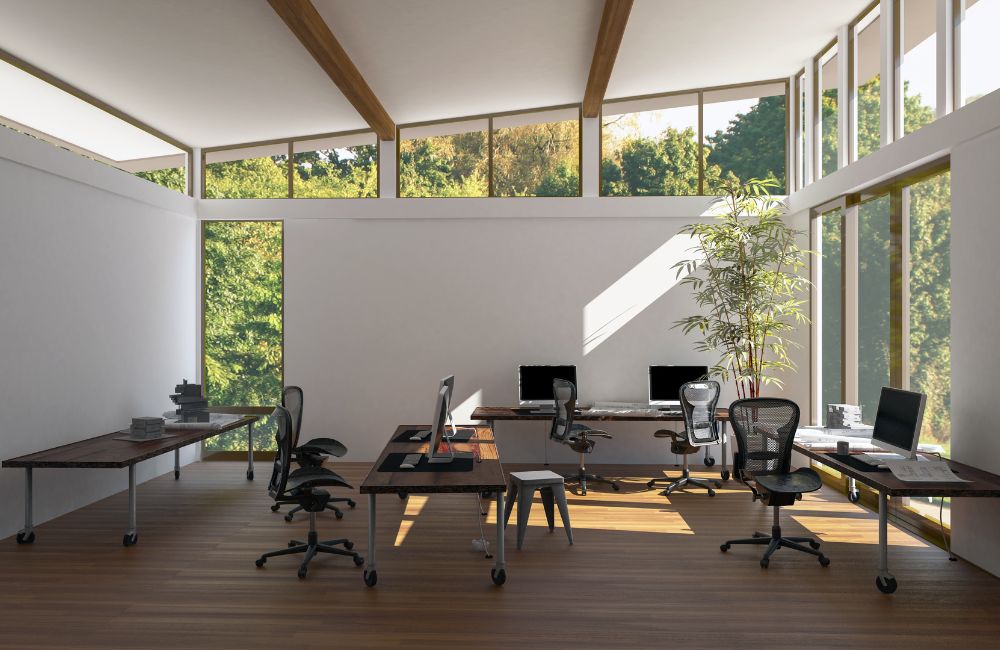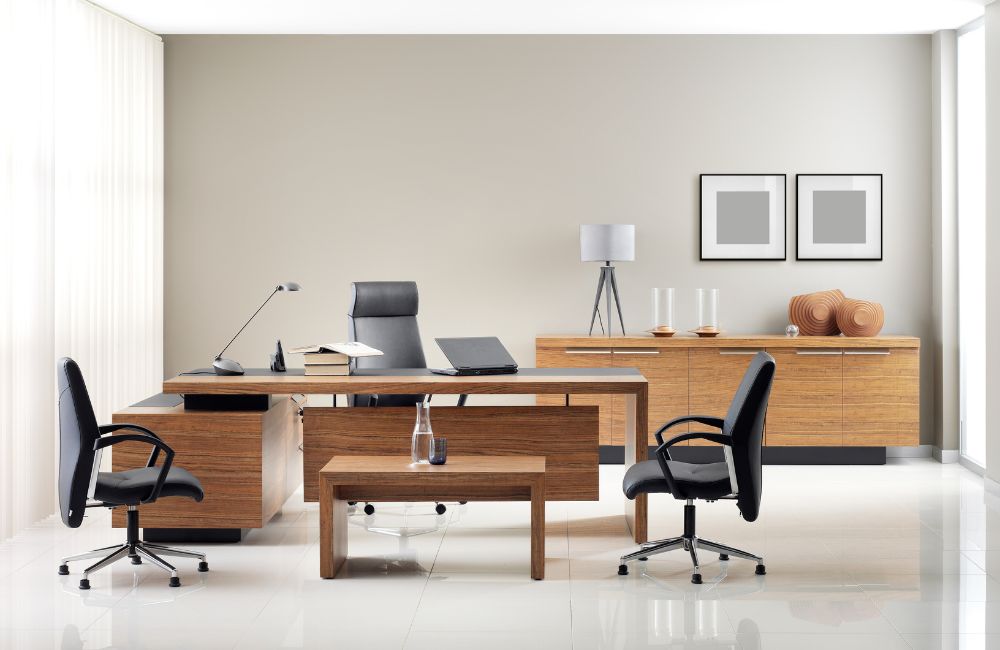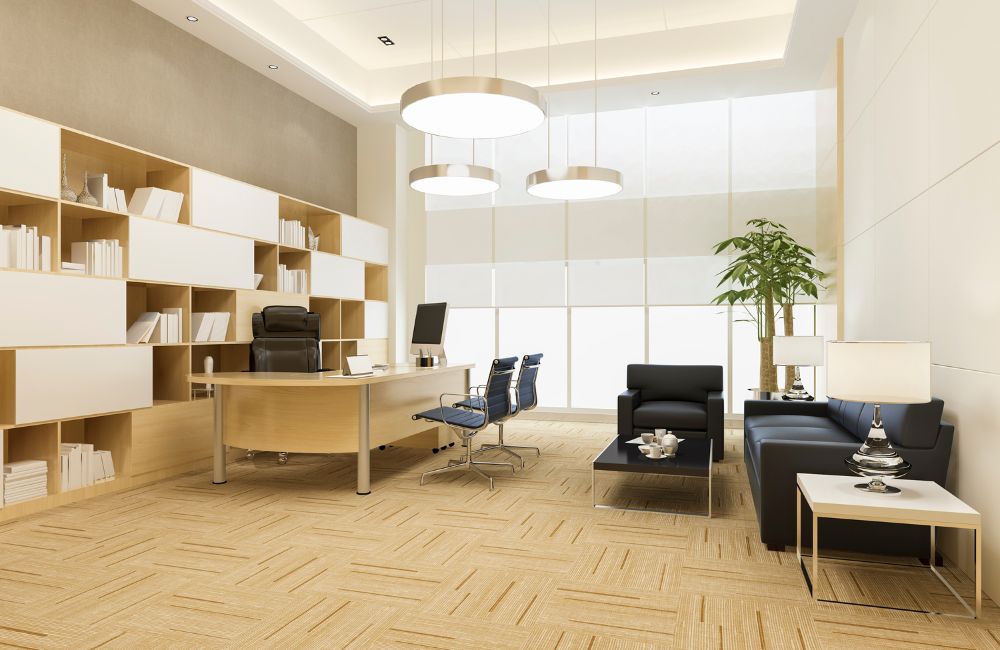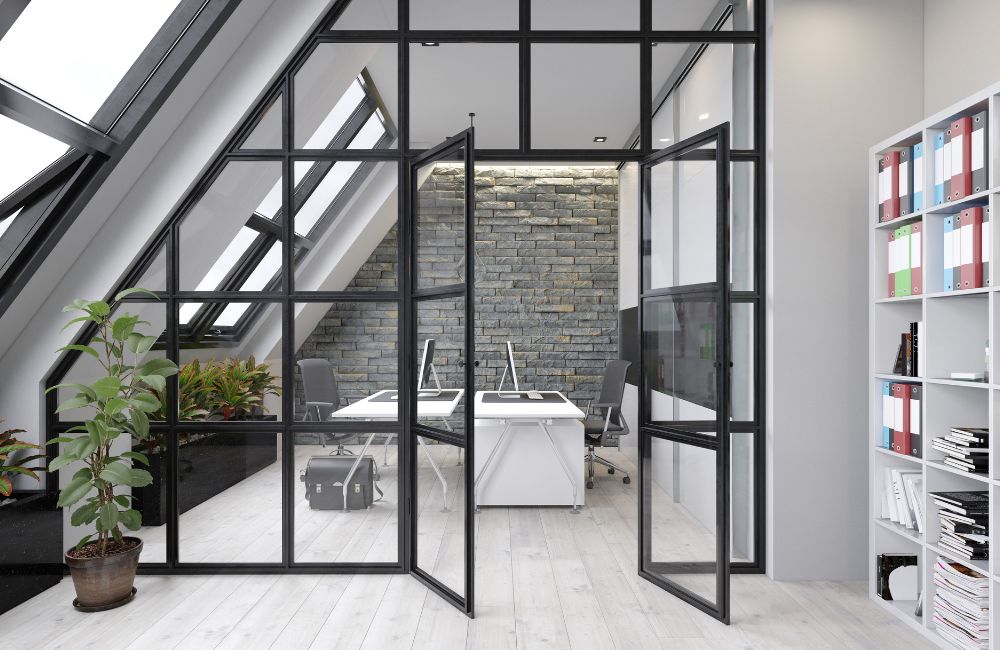5 Ways to Incorporate Contemporary Office Furniture in Your Home Office

Table of Contents
Key Takeaways
Introduction
5 Ways to Incorporate Contemporary Office Furniture in Your Home Office
Tips for Maintaining Contemporary Office Furniture
Frequently Asked Questions
Key Takeaways
✔ Multi-functional furniture maximizes space and adapts to various home office needs.
✔ Minimalist designs reduce distractions and enhance professionalism in home offices.
✔ Tech-friendly office furniture boosts productivity with features like built-in chargers and cable management.
✔ Ergonomic furniture reduces health risks and improves comfort during long work hours.
✔ Neutral color palettes in office furniture provide timeless style and spatial openness.
✔ Regular maintenance preserves the functionality and appearance of contemporary office furniture. |
The concept of a home office has transitioned from a luxury to a necessity for many. According to the Pew Research Center, approximately 22 million employed adults in the U.S., accounting for about 14% of the workforce, now work from home permanently. This shift underscores the importance of creating a workspace that is functional and conducive to productivity and well-being. Incorporating contemporary office furniture into your home office is a brilliant way to achieve this blend of style and function.
5 Ways to Incorporate Contemporary Office Furniture in Your Home Office
Bringing a modern touch to your home office can boost productivity and style. Here are five effective ways to seamlessly integrate contemporary office furniture into your workspace:
1. Choose Multi-functional Pieces
Incorporating contemporary office furniture that serves multiple purposes is an excellent strategy to maximize space and enhance the functionality of your home office. Multi-functional furniture, a hallmark of modern design, allows you to adapt your workspace to suit a range of needs without cluttering your area with additional items.
Key Benefits of Multi-functional Contemporary Office Furniture
- Space Efficiency: These pieces reduce the need for multiple pieces of furniture, freeing up space for other uses.
- Cost Effectiveness: Investing in furniture that serves various functions can be more cost-effective than purchasing separate items.
- Adaptability: Furniture that can adapt to different needs can make a small space highly functional for different tasks like working, studying, or even crafting.
Examples of Multi-functional Contemporary Office Furniture
- Convertible Desks: These desks can often be adjusted in height or expanded in surface area, allowing them to serve as regular desks, standing desks, or even expansive workstations. Homes where space is at a premium but functionality cannot be compromised.
- Expandable Storage Units: Storage units that can be expanded or reconfigured according to the items you need to store. They often feature adjustable shelves, compartments, and sometimes even fold-out options. Storing office supplies, books, technology, and archival items in a customizable format that changes as your storage needs evolve.
- Modular Pieces: Modular contemporary office furniture includes components that can be mixed, matched, and rearranged to suit changing needs, from solitary deep work setups to collaborative spaces. Dynamic home offices that occasionally need to transform into collaborative spaces or lounges.
2. Emphasize Clean Lines and Minimalism
When integrating contemporary office furniture into your home, focusing on clean lines and minimalism not only enhances the visual appeal but also promotes a sense of order and professionalism.
Here are some aesthetic benefits and practical tips for choosing furniture that embodies these design principles:
Aesthetic Benefits of Clean Lines and Minimalism
- Simplicity as Elegance: Contemporary office furniture that features clean lines creates a sleek and elegant environment. This simplicity allows the furniture itself to stand out without overpowering the room, offering a sophisticated backdrop to your daily tasks.
- Enhanced Focus and Productivity: A minimalist design helps reduce visual clutter, which can decrease distractions and enhance your ability to focus. This is particularly beneficial in a home office where domestic distractions are frequent.
- Spatial Harmony: Furniture with a minimalist design tends to appear lighter and less bulky, making it ideal for smaller spaces or any home office looking to maintain an airy feel. Clean lines help in creating an illusion of more space, which can make your office area feel larger and more inviting.
Tips for Selecting Minimalist Contemporary Office Furniture
- Function Over Form: Opt for pieces that prioritize functionality with straightforward designs that avoid unnecessary embellishments.
- Quality Materials: Choose high-quality materials that not only look good but are also durable and easy to maintain. Materials like metal, glass, and light wood are popular in contemporary designs for their neat finish and lasting quality.
- Smooth Textures: Select furniture with smooth surfaces and a matte finish to complement the minimalist theme. Avoid overly textured materials that can create a busy look.
- Integrated Storage: Choose desks and cabinets with built-in storage to keep essential items handy but out of sight. This helps maintain a clean and organized workspace.
- Subtle Separations: Consider using subtle dividers or open shelving units that compartmentalize space without the heaviness of traditional partitions.

3. Incorporate Technology-Friendly Designs
When setting up a home office, one of the most critical considerations is ensuring that your workspace can accommodate all your technological needs. Choosing contemporary office furniture that complements and enhances your use of technology not only boosts productivity but also helps maintain an organized and efficient environment.
Key Features of Technology-Friendly Contemporary Office Furniture
To create an efficient and organized home office, look for furniture with these key technology-friendly features:
- Built-In Charging Stations: Office furniture featuring integrated charging ports, including USB and standard outlets, seamlessly keeps devices powered. This integration eliminates the clutter of excess cords and ensures devices are always ready for use.
- Cable Management Systems: Desks and tables are equipped with channels or clips specifically designed to organize cables neatly. These systems significantly reduce cable clutter, maintaining a clean and organized desk space.
- Adjustable Monitor Arms: These arms or stands attach to desks and can be adjusted to modify monitor height and angle easily. They improve comfort and ergonomics, creating a customizable workstation suitable for multiple screens and different user heights.
- Tech Integration in Storage Units: Bookcases and filing cabinets feature built-in power supplies or configurations to accommodate routers and other tech accessories. This integration streamlines the workspace’s appearance by concealing gadgets within stylish and functional furniture pieces.
Smart Lighting Solutions
Enhancing your workspace with intelligent lighting can improve productivity and reduce eye strain. Consider these smart lighting features to optimize your home office setup:
- Dimmable LED Desk Lamps: Provide customizable lighting levels, reducing eye strain while working at different times of the day.
- Motion-Activated Lighting: Automatically turns on and off to illuminate the workspace only when needed, enhancing energy efficiency.
- Adjustable Color Temperature: Allows you to switch between warm and cool light to optimize the workspace for focus or relaxation, depending on the task.
4. Use Ergonomic Furniture for Comfort
Ergonomics in office furniture plays a vital role in promoting health and enhancing productivity, especially as working hours in the US continue to increase. With extended and irregular working hours often leading to stress, fatigue, and adverse health behaviors like smoking, ergonomic design becomes essential in mitigating these effects. Proper ergonomic furniture helps to minimize muscle fatigue, reduce the risk of injury, and improve comfort during long hours of work.
Benefits of Ergonomic Furniture:
Ergonomic office furniture is designed to enhance productivity and promote well-being. Key benefits include:
- Reduced Discomfort: Alleviates common problems like back and neck pain, carpal tunnel syndrome, and fatigue.
- Increased Productivity: A comfortable setup reduces distractions and boosts focus.
- Improved Posture: Supports proper alignment of the spine and encourages healthy sitting and standing habits.
- Enhanced Flexibility: Adjustable features let users personalize their workspace to fit their needs.
Types of Ergonomic Office Furniture
When selecting ergonomic furniture for your workspace, consider the following types and their benefits to enhance comfort and productivity:
Type | Benefits | Features to Look For |
Ergonomic Chairs | Provides lumbar support and spinal alignment to reduce back pain. | Adjustable height and armrests, lumbar support, breathable fabrics, tilt/swivel functions. |
Adjustable Desks | Allows sitting or standing to minimize spinal strain and improve circulation. | Adjustable height, sturdy construction, ample space for monitors and accessories. |
Monitor Stands | Elevate monitors to eye level to prevent neck strain. | Adjustable height for comfortable screen positioning. |
Keyboard Trays | Provide wrist and forearm support with adjustable trays. | Adjustable angles to keep wrists at ergonomic angles. |
Footrests | Support proper leg positioning to improve circulation. | Adjustable height to match different seating positions. |
Cable Management Tools | Organize cords neatly to prevent trip hazards. | Channels, clips, and holders for a tidy workspace. |

5. Select a Neutral Color Palette
When integrating contemporary office furniture into your home, selecting a neutral color palette is essential for achieving a seamless and professional look. Neutral colors not only complement a wide range of existing home decor but also contribute to a calm and focused atmosphere.
Benefits of Neutral Colors in Office Design
- Versatility: Neutral colors blend effortlessly with different styles and textures, making them a perfect choice for diverse interior designs.
- Timelessness: Unlike bold, trendy colors that might feel outdated as trends change, neutral colors maintain a timeless appeal, ensuring your workspace always feels current.
- Expansive Feel: Lighter neutral colors can make small spaces appear larger and more open, an ideal effect for home offices that are often confined to smaller areas.
How to Choose the Right Shades and Materials
- Assess Your Current Decor: Start by examining the predominant colors and materials in your home. This will help you select office furniture that complements rather than clashes with your existing setup.
- Consider Different Tones
- Soft Whites: Ideal for creating a bright and airy feel; perfect for smaller spaces or rooms with limited natural light.
- Rich Grays: Great for adding a touch of sophistication and modernity, working well in a minimalist or contemporary setting.
- Earthy Beiges: These warm tones bring coziness to a space, making it more inviting and comfortable for long working hours.
- Material Selection Wood: Wooden furniture in soft maple or birch can maintain the neutral theme while adding a touch of warmth.
- Metal: Choose brushed nickel or stainless steel for a more industrial and sleek look that still aligns with neutral color schemes.
- Glass: A glass desk or shelving unit can enhance the contemporary office furniture look while keeping the color palette simple and clean.
Tips for Maintaining Contemporary Office Furniture
When you invest in contemporary office furniture, maintaining its appearance and functionality is crucial to ensure it remains a focal point of your home office.
Here are some practical tips on keeping your furniture in top condition, preserving both its style and utility:
Keep it Clean and Dust-Free
- Daily Dusting: Regularly use a microfiber cloth to gently remove dust from your furniture surfaces. This simple routine prevents the buildup of grime and keeps the furniture looking fresh and new.
- Weekly Wipe-down: For more thorough cleaning, use a damp cloth with mild soap to wipe down the surfaces every week. Be cautious when wringing out the cloth well to avoid leaving water marks that could mar the furniture’s finish.
Avoid Damage from Spills and Scratches
- Use Coasters and Pads: Protect the surface of your furniture by using coasters for drinks and desk pads under writing materials. This prevents scratches and damage from spills.
- Place Protective Mats: Under office chairs, use a protective mat to prevent wear on both the furniture and the flooring, extending the life of both.
Control Exposure to Elements
- Limit Sunlight: Position your furniture away from direct sunlight to avoid fading and warping of the materials.
- Maintain Room Temperature: Keep the environment around your furniture stable, avoiding extreme temperatures and humidity to prevent damage.
Tighten and Lubricate Regularly
- Check and Tighten Fasteners: Inspect and tighten all screws and bolts every six months to ensure the furniture remains sturdy and secure.
- Lubricate Moving Parts: Apply a suitable lubricant to any moving parts, such as drawers or chair mechanisms, to maintain smooth operation and prevent wear.
Handle With Care
- Leather Care: If your furniture includes leather components, condition the leather every few months to keep it supple and prevent cracks.
- Wood Polish: Apply a high-quality wood polish to wooden furniture semi-annually to enhance its luster and create a protective layer against dust and moisture. This not only maintains the aesthetic appeal but also contributes to the longevity of the wood.

Frequently Asked Questions
What materials are commonly used in contemporary office furniture?
Contemporary office furniture commonly uses materials such as metals, glass, and engineered wood to achieve a modern look and functionality. Aluminum and steel are favored for their strength and sleek finish, often used in frames and legs of chairs and desks. Tempered glass is popular for tabletops due to its durability and contemporary aesthetic, while engineered woods provide a lightweight yet sturdy option for larger surfaces like desktops and storage units.
What are the latest trends in contemporary office furniture?
The latest trends in contemporary office furniture focus on enhancing user comfort and promoting a collaborative atmosphere. Ergonomic features are increasingly prioritized, with furniture like adjustable standing desks and ergonomically designed office chairs becoming staples. Additionally, the use of modular workstations allows for flexible office layouts that can be easily adjusted to suit team needs and evolving work practices. The color palette in contemporary office design now leans towards soothing earth tones and pastels, which help to create a tranquil and welcoming environment conducive to productivity.
Can contemporary office furniture be customized?
Customization is a key feature of contemporary office furniture, catering to specific aesthetic and functional requirements of various workplaces. Manufacturers often offer options to modify dimensions, materials, and colors to perfectly fit an office space or match a company’s branding. Custom features like integrated technology docks, personalized logos, or special finishes can also be added to enhance utility and reflect corporate identity, making each piece unique to the client’s needs.
Is contemporary office furniture suitable for all types of work environments?
Contemporary office furniture is exceptionally versatile, making it suitable for various work environments, from open-plan startups to formal corporate offices. Its clean lines and modern designs lend themselves well to creating an appealing and functional workspace that can adapt to various aesthetic preferences and functional demands.
What is the lifespan of contemporary office furniture?
The lifespan of contemporary office furniture typically extends many years, contingent upon the quality of materials and how well it is maintained. High-quality metals, durable glass, and robustly engineered woods can withstand the rigors of daily use, maintaining their appearance and functionality over time. Regular care, including proper cleaning and timely repairs, further extends the furniture’s lifespan, making it a long-term investment for businesses.
Upgrade Your Workspace with Contemporary Office Furniture from Stamford Office Furniture!
Elevate your office in White Plains, NY, with the latest contemporary office furniture from Stamford Office Furniture. Our expertly curated selection in White Plains, NY, blends style with practicality, ensuring that each piece looks fantastic and enhances productivity and comfort. From sleek workstations to ergonomic chairs and stylish storage solutions, we have everything you need to create an inspiring work environment. Stop by the Stamford Office Furniture in White Plains, NY, today, or give us a call to explore our exclusive collection and take the first step toward transforming your office space!





